Do you have this fantasy: Reporters sitting at their desks, waiting for press releases and public relations pitches to pop into their email inboxes? A notion similar to the concept of if you send it, the media will print/post/broadcast your news.
In reality, nothing could be further from the truth. Speaking as a former multi-media journalist and editor, I can tell you that the press, on any given day, has no shortage of news. In fact, news outlets receive much more than they could ever possibly print, post or broadcast. With rare exceptions, PR pitches are deleted, ignored and pushed to the back burner.
That doesn’t mean that what you have to share is not newsworthy. It may be a matter of shifting your perspective. Instead of focusing on what an article or radio/TV interview would mean for you, think about what your story idea may mean for the media.
To truly think like a reporter, you need to really, truly nail down the most important words in a journalist’s language: Who, What, Where, When, Why and How.
Without knowing and effectively communicating these elements, your press release and pitch are as good as dead on arrival.
Here are some things to consider as you put your company’s latest announcement on paper:
1. What’s the news?

It should go without saying that there absolutely needs to be a news component to any press release or tip that you send. You would be surprised, however, by just how many “ideas” trickle in with no news value whatsoever.
Tip: Some good announcements include a grand opening, new construction, the hiring of additional employees or a tie-in with trending news topics.
- Have you buried the lede?
Now that you know what news you’d like to share, have you communicated it effectively? An expression among journalists is to not bury the lede – in other words, don’t bog down your press release with non-essential information. Doing so could mean the difference between deletion and publication.
Tip: The news element of your press release should be in the first sentence. Consider using a few subsequent sentences to tell the rest of the story, or provide necessary detail.
Now that you know the importance of presenting news as early as possible in your interactions with the press, read more about thinking like a reporter in my next blog post.
Theresa Katalinas worked as a print and online reporter and editor for more than a decade before starting her public relations company in 2014. Much of her nonprofit, small business and municipal government clients’ continued success is due to her knowledge of the inner-workings of the publishing industry. For help getting your business or organization the coverage it deserves, email Theresa at theresa@katalinascommunications.com or call 215-519-8833.



3 thoughts on “Why Thinking Like a Reporter is Key to PR Success”